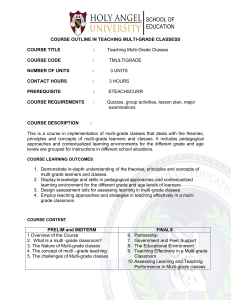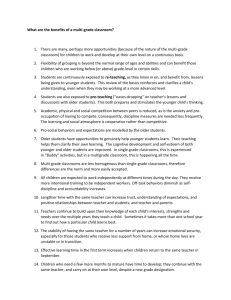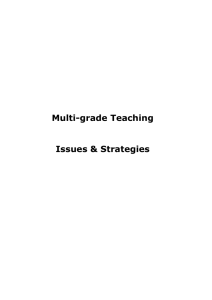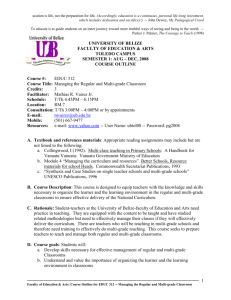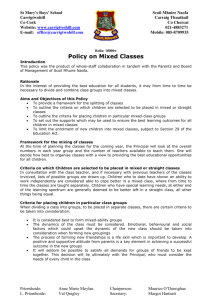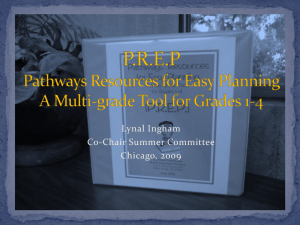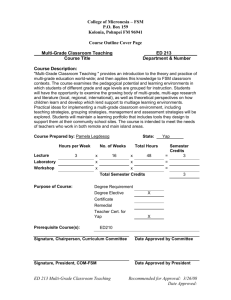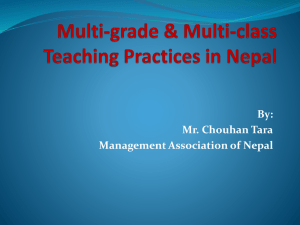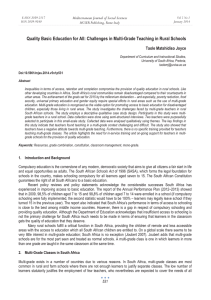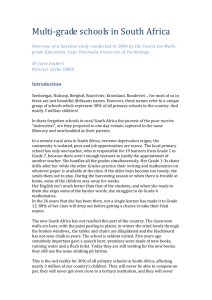A brief note on Efforts to Address Multi-grade Teaching
advertisement
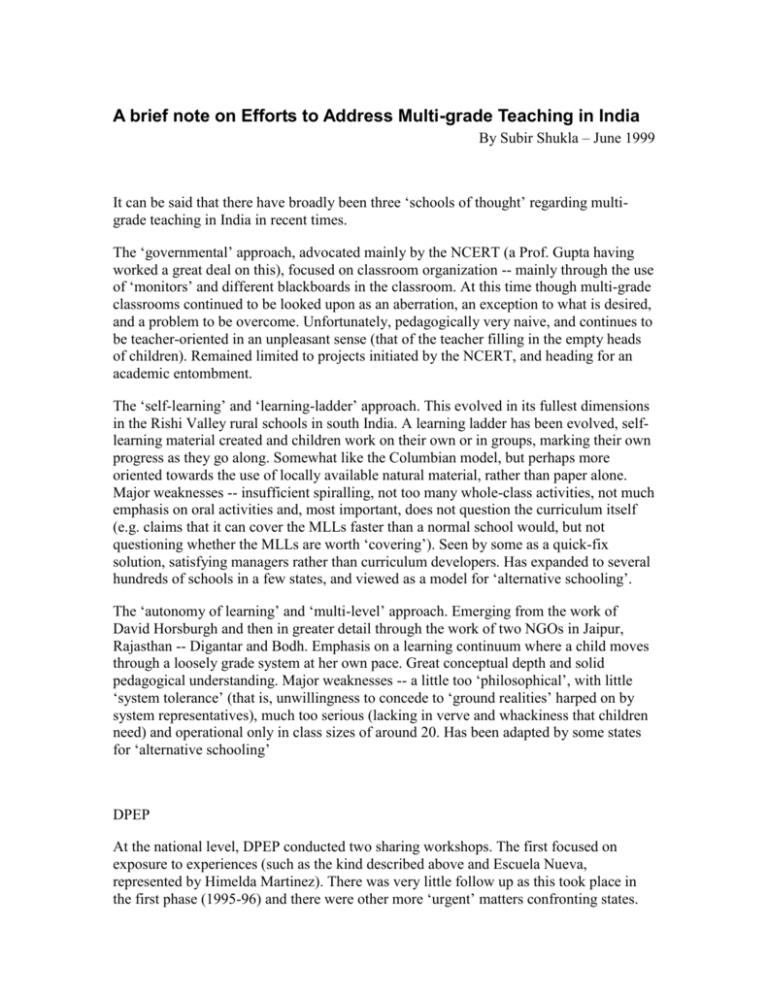
A brief note on Efforts to Address Multi-grade Teaching in India By Subir Shukla – June 1999 It can be said that there have broadly been three ‘schools of thought’ regarding multigrade teaching in India in recent times. The ‘governmental’ approach, advocated mainly by the NCERT (a Prof. Gupta having worked a great deal on this), focused on classroom organization -- mainly through the use of ‘monitors’ and different blackboards in the classroom. At this time though multi-grade classrooms continued to be looked upon as an aberration, an exception to what is desired, and a problem to be overcome. Unfortunately, pedagogically very naive, and continues to be teacher-oriented in an unpleasant sense (that of the teacher filling in the empty heads of children). Remained limited to projects initiated by the NCERT, and heading for an academic entombment. The ‘self-learning’ and ‘learning-ladder’ approach. This evolved in its fullest dimensions in the Rishi Valley rural schools in south India. A learning ladder has been evolved, selflearning material created and children work on their own or in groups, marking their own progress as they go along. Somewhat like the Columbian model, but perhaps more oriented towards the use of locally available natural material, rather than paper alone. Major weaknesses -- insufficient spiralling, not too many whole-class activities, not much emphasis on oral activities and, most important, does not question the curriculum itself (e.g. claims that it can cover the MLLs faster than a normal school would, but not questioning whether the MLLs are worth ‘covering’). Seen by some as a quick-fix solution, satisfying managers rather than curriculum developers. Has expanded to several hundreds of schools in a few states, and viewed as a model for ‘alternative schooling’. The ‘autonomy of learning’ and ‘multi-level’ approach. Emerging from the work of David Horsburgh and then in greater detail through the work of two NGOs in Jaipur, Rajasthan -- Digantar and Bodh. Emphasis on a learning continuum where a child moves through a loosely grade system at her own pace. Great conceptual depth and solid pedagogical understanding. Major weaknesses -- a little too ‘philosophical’, with little ‘system tolerance’ (that is, unwillingness to concede to ‘ground realities’ harped on by system representatives), much too serious (lacking in verve and whackiness that children need) and operational only in class sizes of around 20. Has been adapted by some states for ‘alternative schooling’ DPEP At the national level, DPEP conducted two sharing workshops. The first focused on exposure to experiences (such as the kind described above and Escuela Nueva, represented by Himelda Martinez). There was very little follow up as this took place in the first phase (1995-96) and there were other more ‘urgent’ matters confronting states. A second national level workshop, held in February 1998 proved far more in-depth and solid. All funding agencies participated, hence ensuring considerable international exposure. All states teams arrived after having undertaken fieldwork and state level discussions as preparation. A large number of NGOs and institutions were also present to share their experiences. Each state then made a plan to follow up with small-scale experiments in multi-grade teaching, to be followed up as and how necessary. Resource tie-ups were also facilitated during this exchange. It is clearly recognised that, with over 94% teachers teaching more than one class at a time, the multi-grade situation is a normal situation rather than an exceptional one. My own work in multi-grade teaching: In 1986-87, working with Eklavya (an NGO) I spent around 8 months working with 3 or more classes at the same time in an effort to evolve a means of implementing an emerging activity- and child-oriented pedagogy. Over the next 6 years, this and many other aspects of the project, evolved into an entire curriculum, materials and training package, which has informed the work of many DPEP states. In Gujarat the multi-grade project is essentially an outcome of DPEP’s second national workshop on multi-grade teaching. The year 98-99 was spent in the following: A careful selection of the project area: from among specific clusters and blocks so as to obtain a fairly representative cross section of typical multi-grade situations. Strengthening of the project area for this work: identification and appointment of capable coordinators, resource material and infrastructure for interaction. Identifying and orienting a resource team Basic orientation of teachers on pedagogical and conceptual issues. Analysing the curriculum (Gujarat is one of the stronger MLL states) to see if competencies needed to be clubbed to enable children from consecutive classes to learn together. Steps 4 and 5 listed above did not seem to bear much fruit -- teachers still continued to wonder what it is that they were going to do. It was at this point that I was approached to facilitate this project as an external resource person. Consequently, the first step undertaken was to work intensively in 5 schools, where some of the identified resource persons would pair with teachers and teach for five days according to a plan, analysing it daily and preparing together for the next day -- with a view to find out what tends to work better and what creates difficulties. The 5 schools chosen represent the different and typical multi-grade situations found in Gujarat. The outcome of this small exercise was revealing indeed. Possible directions in which to proceed began to emerge. It became evident that in some aspects all five grades coming together is helpful, in some it is useful is there is a cognitive distance between the two/three grades working together (e.g. grades 2 and 4 working together) and in some it is more useful to have consecutive grades working together. The understanding is that outside the school, children interact in multi-age groups and this natural condition should not be seen as an obstacle; instead it may actually be an advantage. The state now intends to work with teachers and resource persons to enable each teacher to plan out the teaching and learning process for the first month or two of the academic session starting from July, evolve materials if necessary and continue with rigorous follow up/collection of feedback. Such exercises to plan and develop material would take place on a bi-monthly basis. Successful practices would be documented, collated and perhaps evolved into a larger project covering, say, 500 schools. If the next two years led to the consolidation of a ‘multi-grade pedagogy for Gujarat’ it would be scaled to the whole state. In my view, the major difficulty confronting teachers is that they are compelled to stick to grades that specify how much each child is expected to learn in the given period of a year, with no scope for enabling individual and varying paces of learning. This is compounded by the textbook which requires all children to learn the same amount from the same text in the same period. In a far-reaching development, the state of Madhya Pradesh has, recently, begun to consider whether a non-grade system could be thought of. In a Girls’ Education Project that I am working for in Hardoi (Uttar Pradesh), which are essentially single teacher schools run for girls in areas where schools are unlikely to open and which have local women recruited by the community as teachers, an effort has been made to get rid of these constraints by providing a material rich environment that also allows self-paced learning, and is tolerant of class sizes of up to 40+. Work started in October 98, and in case it is successful, it would serve as a breakthrough to help efforts at addressing multi-grade issues elsewhere. Subir Shukla III/108 Kirti Apts, 16 Mayur Vihar Phase I Extn., Delhi 110 091, INDIA Ph: 91-011-2717204 E-mail: primary@del3.vsnl.net.in
